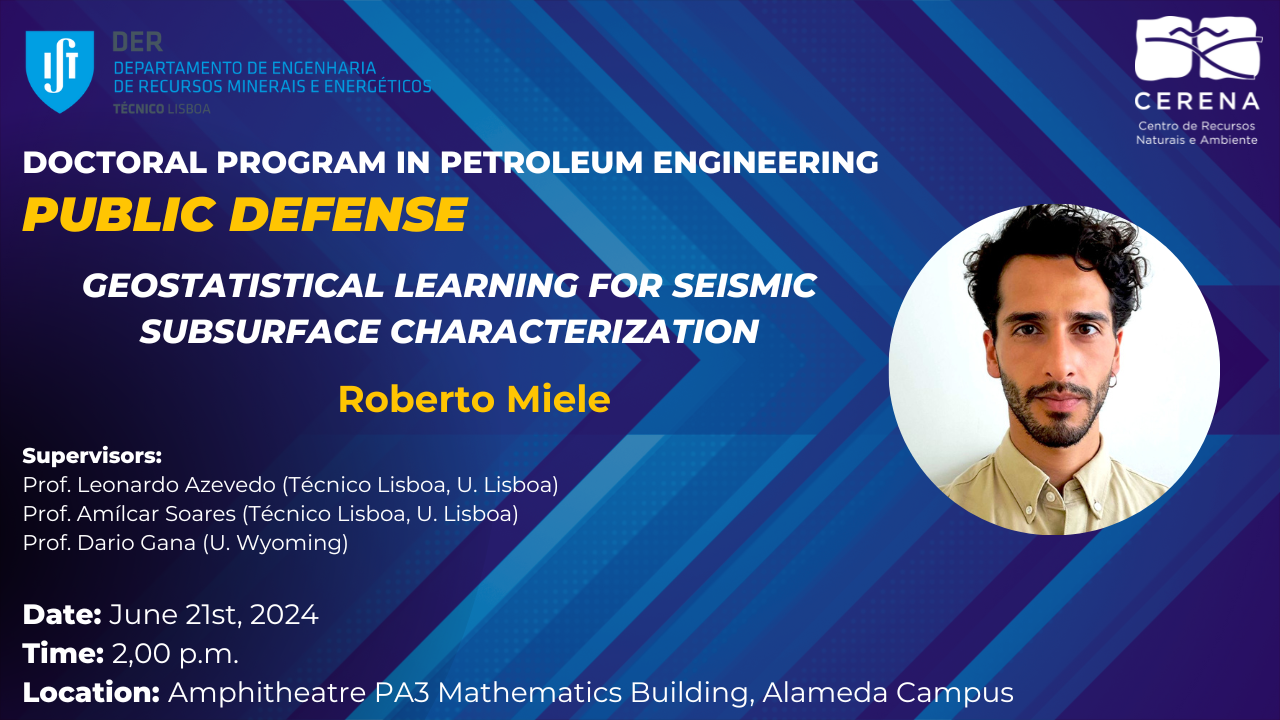PhD. Public Defense in Petroleum Engineering

Candidate: Roberto Miele
Thesis Title: "Geostatistical Learning for Seismic Subsurface Characterization"
Date: June 21st, 2024
Time: 14:00h
Location: Amphitheatre PA3 (Mathematics Building, -1 floor)
Supervisors: Prof. Leonardo Azevedo, Prof. Amílcar Soares, Prof. Dario Gana
Abstract:
Probabilistic inversion of seismic reflection data is a fundamental step to predict the spatial distribution of the subsurface petro-elastic properties and facies, and their uncertainty, in energy exploration and environmental monitoring tasks. The geological plausibility and accuracy of the predictions are highly dependent on the rock physics adopted to link the rock and elastic domains. Nonetheless, rock physics models may not be used directly for the characterization of permeability, as they may represent an unrealistic approximation of reality. Besides, conventional geostatistical rock physics seismic inversion methods lack a means to quantify uncertainty associated with the adopted rock physics models, leading to biased predictions and misrepresented uncertainty. Besides, these models
This thesis proposes two iterative geostatistical inversion approaches to address these issues. The first constrains geostatistical permeability predictions simultaneously using seismic data misfit and rock-physics-based information, improving model perturbation updates. The second addresses rock physics uncertainty by the integration of the calibration error, estimated at the well location, within the iteratively geostatistical seismic rock physics inversion procedure.
To improve the efficiency and quality of facies prediction, this thesis further explores deep learning solutions for stochastic inverse modeling, overcoming challenges related to uncertainty quantification and computational cost. Variational autoencoder and generative adversarial network are proposed for full-stack seismic data inversion directly for facies and facies-dependent acoustic impedance. These modeling methods are coupled with a state-of-the-art inference method for efficient inverse modeling. The work further proposes a generative adversarial network for the inverse modeling of complex facies distributions in a single training step, avoiding the complexity of two-steps approaches.
The methodologies are demonstrated on synthetic and real case application and compared to baseline methods. Results show that the proposed solutions enhance inversion prediction accuracy and uncertainty quantification, overcoming reference methodologies.
ptibility (MS).
However, mapping geophysical data into numerical subsurface models concerns solving an
ill-posed and nonlinear geophysical inverse problem with multiple solutions. While
deterministic geophysical inverse solutions allow predicting smooth representations of the
subsurface, they do not account for uncertainties and are unable to directly integrate direct
observations, a probabilistic framework allows overcoming these limitations.
This thesis combines the advantages of FDEM induction measurements with the potential of
probabilistic inversion and introduces a geostatistical FDEM inversion method to
simultaneously model the spatial distribution of the subsurface EC and MS and assess the
uncertainty of the predicted results. The proposed method is benchmarked with an alternative
statistical-based FDEM inversion method. Since probabilistic inversion methods are
computationally demanding when solving for large-scale three-dimensional inverse problems,
the iterative geostatistical FDEM inversion is coupled with random tensor decomposition to
alleviate the computational burden. From a multi-geophysical inversion approach, this thesis
also presents a joint inversion method of electrical and electromagnetic data to reduce the
uncertainty of the predicted subsurface models in near-surface applications. The methods are
illustrated in realistic synthetic and real applications.
KEYWORDS: Near-surface modelling, Geostatistical FDEM inversion, FDEM data, Electrical
data, Joint geophysical inversion.
